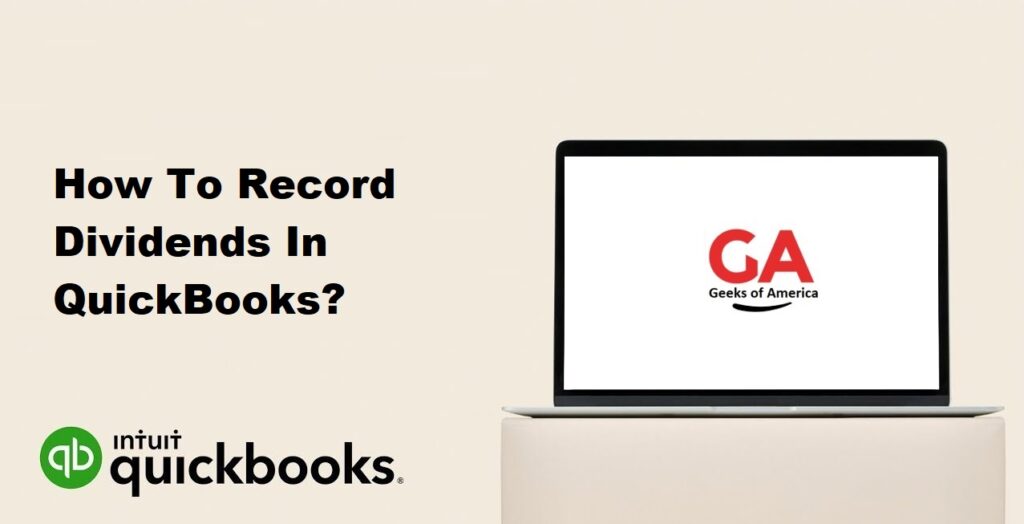Dividends are a distribution of profits made by a corporation to its shareholders. As a business owner, it’s important to accurately record dividends in your accounting system to maintain proper financial records and comply with tax regulations. QuickBooks, both in its Desktop and Online versions, provides tools and features that can help you record dividends seamlessly. In this guide, we will walk you through the step-by-step process of recording dividends in QuickBooks, ensuring accurate financial reporting and tracking of shareholder distributions.

I. Understanding Dividends:
A. Definition and Types of Dividends:
Dividends are distributions of profits made by a corporation to its shareholders. There are two common types of dividends: cash dividends and stock dividends. Cash dividends involve the distribution of cash to shareholders, while stock dividends involve the issuance of additional shares of stock to shareholders.
B. Importance of Recording Dividends in QuickBooks:
Accurately recording dividends in QuickBooks is crucial for maintaining proper financial records, tracking shareholder distributions, and complying with tax regulations. Properly recorded dividends help provide a clear picture of a company’s financial health and ensure accurate reporting to shareholders.
Read Also : How To Set Up QuickBooks 401K In QuickBooks Desktop & Online?
II. Preparing to Record Dividends:
A. Determine Dividend Payment Method:
Decide on the dividend payment method, whether it will be in cash or stock. This decision will impact the recording process in QuickBooks.
B. Review Shareholder Information:
Gather the necessary information about the shareholders, including their names, addresses, and ownership percentages. Ensure this information is up to date in QuickBooks.
C. Set Up Dividend Account in QuickBooks:
Create a dividend account in QuickBooks to track dividend transactions separately. This allows for easy identification and reporting of dividend payments.
Read Also : How To Import Budget Into QuickBooks Desktop?
III. Recording Dividends in QuickBooks Desktop:
A. Set Up Dividend Payment in Chart of Accounts:
Access the Chart of Accounts in QuickBooks Desktop and create a new account for recording dividend payments. Choose the appropriate account type, such as an Equity account.
B. Create Dividend Item:
Set up a dividend item in QuickBooks Desktop. This item represents the dividend payment and will be used when recording dividend transactions.
C. Record Dividend Payments to Shareholders:
Enter the dividend payments to shareholders using the dividend item previously created. Ensure the payments are accurately allocated to the respective shareholders based on their ownership percentages.
Read Also : How To Import Budget Into QuickBooks Online?
IV. Recording Dividends in QuickBooks Online:
A. Set Up Dividend Payment in Chart of Accounts:
Navigate to the Chart of Accounts in QuickBooks Online and create a new account for tracking dividend payments. Select the appropriate account type, such as an Equity account.
B. Create Dividend Category:
Set up a dividend category in QuickBooks Online. This category represents the dividend payment and will be used when recording dividend transactions.
C. Record Dividend Payments to Shareholders:
Enter the dividend payments to shareholders using the dividend category previously created. Allocate the payments to the respective shareholders based on their ownership percentages.
Read Also : How To Record A Bounced Or Returned Check In QuickBooks Desktop?
V. Tracking Dividends and Shareholder Distributions:
A. Reconciling Dividend Payments:
Regularly reconcile dividend payments recorded in QuickBooks with the bank statements to ensure accuracy and identify any discrepancies.
B. Generating Dividend Reports:
Utilize QuickBooks’ reporting features to generate dividend reports, such as shareholder dividend summaries and dividend payment history. These reports provide an overview of dividend distributions and assist in financial analysis.
C. Auditing Dividend Transactions:
Conduct periodic audits of dividend transactions to ensure accuracy and compliance. Review dividend payments, supporting documentation, and any necessary adjustments.
Read Also : How To Export 1099 Data From QuickBooks?
VI. Dividend Tax Implications:
A. Understanding Tax Treatment of Dividends:
Familiarize yourself with the tax regulations and treatment of dividends applicable to your jurisdiction. Different tax rules may apply to cash dividends and stock dividends.
B. Generating Tax Reports for Dividends:
Use QuickBooks’ tax reporting features to generate dividend-related tax reports, such as Form 1099-DIV. These reports assist in fulfilling tax obligations and reporting dividend income to shareholders.
C. Consulting with a Tax Professional:
Seek advice from a qualified tax professional to ensure compliance with tax laws, understand tax implications, and make informed decisions regarding dividend distributions.
Read Also : How To Update QuickBooks Company File?
VII. Best Practices for Recording Dividends in QuickBooks:
A. Maintain Accurate Shareholder Records:
Keep accurate and up-to-date records of shareholder information, including ownership percentages and contact details. Regularly update this information in QuickBooks.
B. Regularly Reconcile Dividend Payments:
Perform regular reconciliations of dividend payments to ensure accuracy and identify any discrepancies or errors. Reconciliations help maintain the integrity of financial records.
C. Keep Documentation of Dividend Declarations:
Retain documentation of dividend declarations, such as board meeting minutes or resolutions, to support dividend distributions and demonstrate compliance with corporate governance requirements.
Read Also : How To Add A Beginning Balance In QuickBooks Online?
VIII. Conclusion:
Recording dividends accurately in QuickBooks is essential for maintaining proper financial records, tracking shareholder distributions, and complying with tax regulations. By following the step-by-step instructions provided in this guide, you can confidently record dividends in QuickBooks Desktop or QuickBooks Online. Remember to review shareholder information, set up appropriate accounts or categories, and regularly reconcile dividend payments. With QuickBooks’ robust features and proper dividend recording practices, you can ensure accurate financial reporting and effectively manage shareholder distributions.
